|
 Secure Site
Secure Site
|
 |
Archive for the 'Zen Gardens' Category
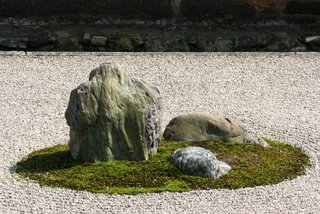 Ryoanji Zen Garden, Kyoto, Japan Steve McIntosh, Inventor of the Zen Clocks and Tehya (his wife) were most fortunate to visit the Ryoanji Zen Temple in Kyoto, Japan before their son, Peter McIntosh was born. It was a most peaceful and memorable trip. Below is a description of the ancient site:
Ryōan-ji is a Zen Temple located in northwest Kyoto, Japan. The garden consists of raked gravel and fifteen moss-covered boulders, which are placed so that, when looking at the garden from any angle (other than from above) only fourteen of the boulders are visible at one time. It is traditionally said that only through attaining enlightenment would one be able to view the fifteenth boulder.
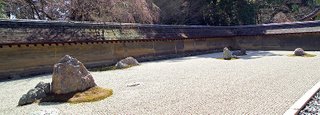 Ryōan-ji Japanese gardens are a living work of art in which the plants and trees are ever changing with the seasons. As they grow and mature, they are constantly sculpted to maintain and enhance the overall experience; hence, a Japanese garden is never the same and never really finished. The underlying structure of a Japanese garden is determined by the architecture; that is, the framework of enduring elements such as buildings, verandas and terraces, paths, tsukiyama (artificial hills), and stone compositions. Over time, it is only as good as the careful maintenance that it receives by those skilled in the art of training and pruning. Part of the art is to keep the garden almost static, like a painting.
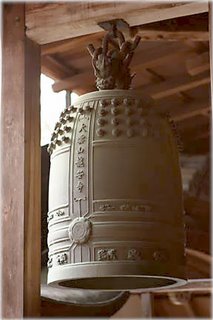 Ryōan-ji Temple Bell
Now & Zen Headquarter Store
1638 Pearl Street
Boulder, CO 80302
 - Zen Timepiece Inspired by Ryōan-ji Temple Bell
The Zen Timepiece – a Gong Meditation Timer is the result of ten years of product evolution at Now & Zen, and we trust that you will find it a delight and a pleasure. The Zen Timepiece’s greatest beauty is in its sound.
Once you take a moment to adjust the strike force and position of the bowl/gong to your liking, your ears will be treated to the lovely tones of the bowl’s long-resonating ring. We recommend you set the clock so that the bowl is sounded in the lower end of its range, because this is where it sounds the sweetest.
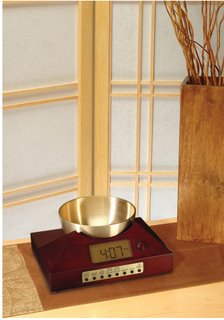 Gong & Chimes
Now & Zen’s Gong and Chime Store
1638 Pearl Street
Boulder, CO 80302
(800) 779-6383
Posted in Beauty, Chime Alarm Clocks, Japanese Inspired Zen Clocks, Meditation Timers, Meditation Tools, Now & Zen Alarm Clocks, Truth, Zen Gardens, zen monks, Zen Timepiece by Now & Zen, Zen Timers
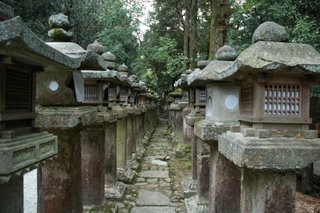 Stillness
In the larger scheme of things, our days on this planet are few and precious, so it seems fitting that we should begin each day with grace and beauty. Used as an alarm clock, your Zen Timepiece thus serves as a useful reminder that each day is a new and sacred opportunity to live life to its fullest.
 Zen Timepiece in Maple But in addition to its use as an alarm clock, your Zen Timepiece is also an aesthetically-sophisticated timer that enhances practice activities and social gatherings. It can also serve as a “mindfulness bell” that periodically calls you to stillness.
Founded in Boulder, Colorado in 1995, Now & Zen’s mission is to create natural lifestyle products that make a real difference in people’s lives. The growing preference for natural foods and natural fibers is carried forward by Now & Zen in the natural acoustic sounds and natural hardwood materials featured in every Now & Zen product. Our way of describing the essence of a natural lifestyle is: quality of thought, stillness of being.
 The Zen Alarm Clock Store Now & Zen’s Shop – Mindfulness Bells & Chime Timers
1638 Pearl Street
Boulder, CO 80302
(800) 779-6383
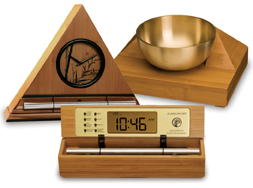 Tibetan Singing-bowl Timer & Chime Mediation Clocks
Posted in Meditation Timers, Meditation Tools, Natural Awakening, Now & Zen Alarm Clocks, Zen Gardens, Zen Timepiece by Now & Zen, Zen Timers
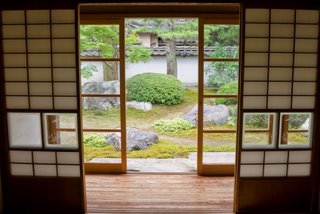 Zen Garden Calligraphy and the art of ink painting has inspired the design of our Zen Clocks.
One of our most popular dial faces features the calligraphy character for “dream” set against a rice paper or bamboo background. Japanese characters are called “kanjis” and so this dial is called the “Dream Kanji.”
Another dial face features the kanji for “Inner Peace” set against the raked sand of a Zen rock garden.
Although our “Bamboo motif” dial face has no calligraphy per se, it is inspired by the tradition of ink painting, which is a close relative of calligraphy.
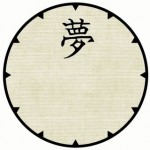 Dream Kanji Dial 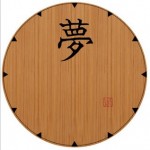 Bamboo Kanji Dial  Zen Garden Dial 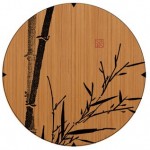 Bamboo Motif Dial
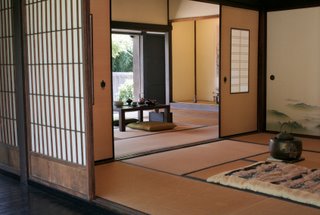 Japanese Interior Living Space Below is a description of this ancient art.
The flowing, brush-drawn Japanese language lends itself to complicated calligraphy. Calligraphic art is often too esoteric for Western audiences and therefore general exposure is very limited. However in East Asian countries, the rendering of text itself is seen as a traditional artform as well as a means of conveying written information. The written work can consist of phrases, poems, stories, or even single characters. The style and format of the writing can mimic the subject matter, even to the point of texture and stroke speed. In some cases it can take over one hundred attempts to produce the desired effect of a single character but the process of creating the work is considered as much an art as the end product itself.
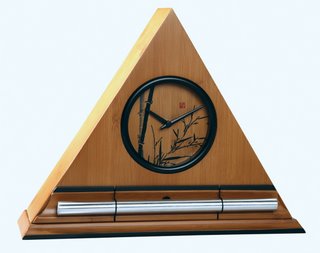 Calligraphy and the Art of Ink Painting used in Zen Alarm Clocks This art form is known as ‘Shodo’ which literally means ‘the way of writing or calligraphy’ or more commonly known as ‘Shuji’‘learning how to write characters’.
Commonly confused with Calligraphy is the art form known as ‘Sumi-e’ literally means ‘ink painting’ which is the art of painting a scene or object.
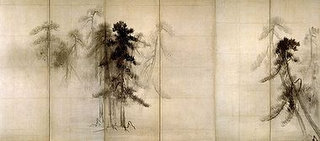 Japanese Ink Painting
Visit Now & Zen’s Showroom
1638 Pearl Street
Boulder, CO 80302
(800) 779-6383
Posted in Chime Alarm Clocks, Japanese Inspired Zen Clocks, Now & Zen Alarm Clocks, Zen Gardens
 yoga After a busy day of work, kids, groceries, and stressing over global warming weather conditions, how often do you sit down and think about how accomplished you are; how many people you’ve helped; how you know you can do it again tomorrow because you’ve truly got what it takes to change the world? Most likely you collapse in a heap on the couch, overwhelmed by feelings of struggle or ineffectiveness, negative self-image, inertia, or the everyday kitchen-sink blahs.
Yoga can help you through those doldrums. Like a piece of string tied around your finger, yoga serves as a reminder to acknowledge all the good things about yourself—those accomplishments and qualities you’ve somehow forgotten. It gives you the confidence and oomph you need to shift feeling states—all you need to do is roll out that yoga mat and get started. In fact, one of the first things that yoga will actually remind you about is to do yoga!
Those of us who practice yoga regularly—the precise postures, deep breathing, and meditative awareness—have learned that no matter what mood we’re in at the beginning of our yoga session, we always feel better by the end. If we start out feeling stiff, we become looser and more fluid. If we feel sluggish, our energy perks up. If we were hyper-stimulated when we first sat on our mat, we end up calmer and more balanced when we leave. On days when we’re overwhelmed, yoga brings a sense of grounding and connection. When distressing world events lead to feelings of helplessness, the strength we exert on the mat will help us tap into a sense of personal power that allows us to move forward in life. Instead of feeling pulled in all directions, we begin to feel connected to ourselves.
Yoga works like this every time, no matter what reason you have for doing (or starting) it. Getting in shape, gaining strength and flexibility, improving your posture, digestion, or sex life—all these good things are already within your grasp. That strong, fluid, healthy, sexy you is just waiting to be uncovered, just longing for an invitation to show up at the party. Yoga serves as a reminder that the strong, able, open-hearted, and confident person you wish to be already exists, at least on the inside.
I’ve had plenty of intimidating experiences that yoga rescued me from, such as the time I gave a yoga lesson to a regular private client—an upper-crust member of high society—and her guest from the British royal family decided to join in. If I had been introduced to him before the class, I’m sure my palms would have started sweating, and I would have done a Ralph Kramden, “A hummuna hummuna.” But the class was already in full swing and, filled with confidence about the benefits of yoga, I didn’t feel the least bit shy as I warmly welcomed him onto the mat.
As I made some hands-on adjustments to the now shirtless royal, I thought to myself, “Is it OK to touch someone this close to the crown?” But, at that moment, I was the expert and I knew that I could help him with his overly flexible joints. He couldn’t have been nicer and more appreciative, and we had a nice chat after the class, during which I wished I were wearing a cuter outfit.
Even though I wasn’t doing the yoga with my two students, I benefited from exploring the qualities that they were practicing under my guidance: standing on one’s own two feet, finding balance, resting in one’s breath, taking chances, being steady and straightforward, letting go, falling down, having fun, and taking a fresh start. These are all yogic gateways toward remembering the feeling of confidence in any situation.
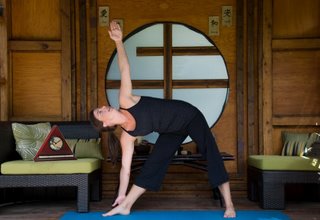 yoga Meditation master Chogyam Trungpa taught that we are all born with basic goodness, and when we acknowledge this, we connect with a sense of primordial confidence. Although this confidence already lives within us, we can sometimes lose our link to it because of negative emotions, such as fear, jealousy, or hatred. Alas, those feelings live there, too, but they don’t have to take over our entire mental and emotional landscape, leaving no room for the natural faith we have in who we are and what we can do. Just like in cooking, we can fold our natural self-confidence right into our self-consciousness to create a new and healthier blend. Who knows? Maybe with enough yoga practice, the confidence will rise to the top just like the yummy cream in a farm-fresh bottle of milk.
This yoga sequence is designed to help you develop building blocks you can use to reconnect to your own inherent self-confidence. Take your time, and try to release any expectations. The opposite of self-confidence is wishing and hoping, which always get us in trouble. Let go of that habit, and try to stay connected to your own deep breath. Have faith in your own good heart.
Mountain Pose With Arms Up. Stand with your feet directly below your sitting bones so you feel firmly planted. At the same time, actively reach through every fingertip up to the sky. This pose can be done almost anywhere, anytime, and is a great reminder of how good it feels to be able to stand on your own two feet. Let your breath be full and notice how your front, back, and sides fill with breath and soften back in toward your strong and quiet center. Hold this position for five deep breaths.
Warrior Lunge. Bend both knees. Step your left foot back, and balance on the ball of the foot. Make sure your left leg is straight with strong energy extending out your left heel. Keep your right leg parallel to the ground, knee above heel. Use your abs to keep your spine vertical. Even though your arms are getting tired, hold them up with commitment for a little longer. Let your gaze rest on something at eye level across the room to help you find balance and steadiness within the exertion of this full-body position. Stay here for three to five breaths.
Open Warrior (Warrior 2). On an exhale, turn your back heel inward and lower it to the ground, so your left foot is roughly perpendicular to your right, and the arch of your left foot is in line with the heel of your right. Pivot your hips and torso to face outward over your left foot. Extend your arms away from each other at shoulder height. As you breathe in and out for five to eight breaths, let your open body position invite you to feel expansive, open-hearted, and confident.
Reverse Warrior 2. On an inhale, lean away from your bent knee, stretching your right arm overhead as your left hand rests on your left thigh for support. Stay here for three breaths and indulge in the feeling of breath nourishing your body. Even though your legs are getting tired, can you let your breath give you a second wind? This is great practice for staying the course when you feel tired or discouraged.
Lunge. On an exhale, cartwheel your hands to the floor, on either side of your right foot. Bring your left knee to the ground with your toes pointing behind you, in line with your body. Your right knee should be over your right heel. Reach out through the crown of your head and out through your back heel. Focus on your whole body, inhaling and exhaling through your nose for five cycles.
Twisted Lunge. On an exhale, twist to the right and place your hands in prayer position. Press the back of your left elbow against the outside of your right knee as you draw up through your spine. Relax your mind once again and see if you can feel long, strong, and expansive. Stay here for 5 breaths. Lengthen your spine with each inhale, and twist a little bit more deeply (from your core) with each exhale.
Forward Fold. Exhale and place your hands on the floor on either side of your right foot. Inhale; on the next exhale, step your back foot forward and place it next to your right foot. Let your head hang between your arms and bend your knees if it’s more comfortable. Stay here for as long as you want but try to focus on your breath. Notice what the breath feels like when you are in this upside-down situation. It will be helpful when life throws you for a loop.
adapted from Natural Solutions by Cyndi Lee
Use our unique “Zen Clock” which functions as a Yoga Timer. It features a long-resonating acoustic chime that brings your meditation or yoga session to a gradual close, preserving the environment of stillness while also acting as an effective time signal. Our Yoga Timer & Clock can be programmed to chime at the end of the meditation or yoga session or periodically throughout the session as a kind of sonic yantra. The beauty and functionality of the Zen Clock/Timer makes it a meditation tool that can actually help you “make time” for meditation in your life. Bring yourself back to balance.
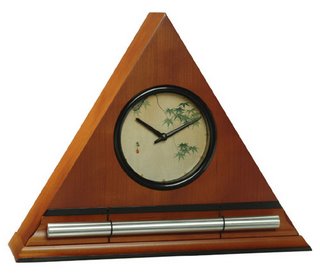 Zen Alarm Clocks and Yoga Timers with Gentle Chime Now & Zen – The Yoga Timer Store
1638 Pearl Street
Boulder, CO 80302
(800) 779-6383
Posted in Yoga Timer, Yoga Timers by Now & Zen, Zen Alarm Clock, Zen Gardens
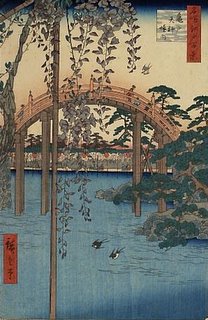 Kamedo Tenjin Shrine: drum bridge in the garden, Hiroshige ukiyo-e During the Asuka period (538-710), gardens were supposed to express Buddhism and Taoism through replicating the mountainous regions in China.
During the Heian period (794-1185), gardens shifted from solely representing religious beliefs to becoming, “a place for ceremonies, amusement, and contemplation” (Miller).
 peter in a japanese garden In the Kamakura and Muromachi periods (1185-1573), a great many gardens were created during these two time periods due to improved garden techniques and the development of Syoinzukuri style. Zen beliefs were also flourishing at this time and had great influences over garden techniques and purposes. Another factor that allowed gardens to flourish stems from the fact that the shoguns simply enjoyed gardens.
After the Muromachi Period, Japanese tea ceremonies became an intricate part of Japanese culture. Sen no Rikyu (1517-1591) created the traditional style of a tea house where there was usually a roji (“dewy path”) leading to the house. Besides the tea houses, gardens constructed in the Edo period (1603-1868) reflected the tastes and style of each individual shogun ruler. Instead of being a religious symbol, gardens shifted to being a symbol of a shogun’s prestige and power (Miller).
adapted from wikipedia.org
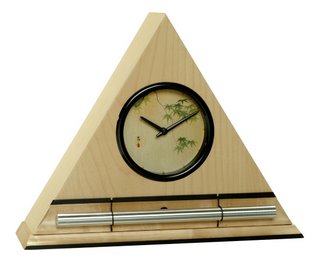 Zen Clocks by Now & Zen Now & Zen
1638 Pearl Street
Boulder, CO 80302
Posted in Japanese Inspired Zen Clocks, Now & Zen Alarm Clocks, Progressive Awakening, Zen Gardens, Zen Timers
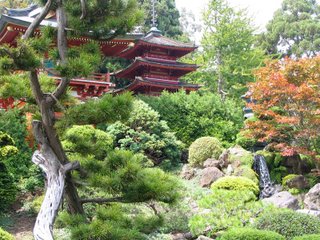 Hagiwara Japanese Tea Garden in San Francisco, California, showing the use of stone, water and plants Tsukiyama Gardens often copy famous landscapes from China or Japan, and they commonly strive to make a smaller garden appear more spacious.
This is accomplished by utilizing shrubs to block views of surrounding buildings, and the garden’s structure usually tries to make onlookers focus on nearby mountains in the distance. By doing this, it seems that the garden has the mountains as part of its grounds. Ponds, streams, hills, stones, trees, flowers, bridges, and paths are also used frequently in this style.
adapted from wikipedia.org
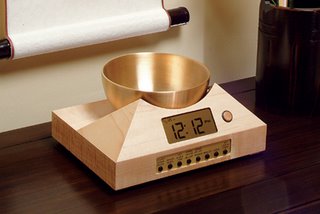 Zen Timer for meditation by Now & Zen Inc.
Now & Zen
1638 Pearl Street
Boulder, CO 80302
(800) 779-6383
Posted in Beauty, Natural Awakening, Now & Zen Alarm Clocks, Progressive Awakening, Zen Gardens, Zen Timepiece by Now & Zen, Zen Timers
 creating water gardens, a mindfulness practice One mindfulness practice we enjoy is to create a water garden. It can be calming to find rocks and create a special space for meditation.
Finding a good placement of rocks is similar to arranging a Zen garden or Japanese rock garden. Well-done, intuitive placement of rocks can stimulate a feeling of peace or Zen while also achieving a practical effect.
 Bamboo Zen Clock, a meditation timer
Now & Zen
1638 Pearl Street
Boulder, CO 80302
Posted in Japanese Inspired Zen Clocks, Meditation Timers, Meditation Tools, mindfulness practice, Well-being, Yoga Timer, Zen Gardens, Zen Timers
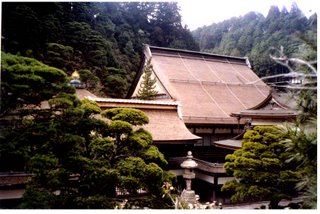 Koya-san, Japan Mount Kōya (Kōya-san) is the name of mountains in Wakayama prefecture to the south of Osaka. There is no one mountain officially called Kōya-san in Japan.
First settled in 819 by the monk Kukai, Mt. Koya is primarily known as the world headquarters of the Koyasan Shingon sect of Japanese Buddhism. Located in an 800 m high valley amid the eight peaks of the mountain (which was the reason this location was selected, in that the terrain is supposed to resemble a lotus plant), the original monastery has grown into the town of Koya, featuring a university dedicated to religious studies and 120 temples, many of which offer lodging to pilgrims.
adapted from wikipedia.org
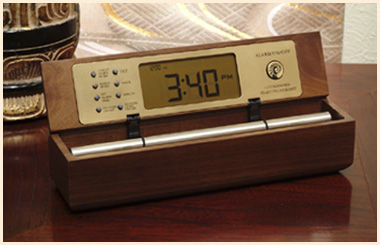 Digital Zen Alarm Clock Now & Zen
1638 Pearl St.
Boulder, CO
Posted in Chime Alarm Clocks, Japanese Inspired Zen Clocks, Meditation Timers, Meditation Tools, Now & Zen Alarm Clocks, Zen Gardens, zen monks, Zen Timers
|
|
|
|